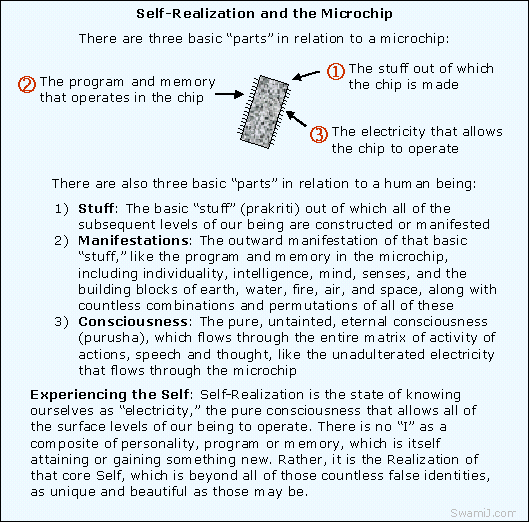|
|
Yoga
Sutra 4.31:
Knowables Become Few
(Previous
Next Main)
 Seeing there is little to know: After the journey of self-exploration
through the gross and subtle levels of our being, there comes a point of
realizing that there is really little to know. Everything we know, every
object we perceive is seen to have arisen by the veiling process that
covers over some subtler object. Seeing there is little to know: After the journey of self-exploration
through the gross and subtle levels of our being, there comes a point of
realizing that there is really little to know. Everything we know, every
object we perceive is seen to have arisen by the veiling process that
covers over some subtler object.
There never was much to know: The yogi comes to see that, not only is
there little more to know after having tread this journey, there was, in
fact, little to know in the first place. The construction of our being was
not so complicated after all.
This simplicity is inspiring: The recognition of this simplicity can be
very inspiring for the sadhaka (one who treads the path of sadhana,
spiritual practices). It gives a comforting reassurance that, while this
world of names and forms appears to be vast, with many, many things to
learn, there is an underlying simplicity. Enlightenment or
Self-realization is not so far away; there is little to know.
Great ones say it is close: All of the great teachers have said this
throughout human history, in one voice, that the goal of the journey is not so far
away. The path may not be easy, but it is seen to be simple. As Swami Rama
has said, "You really do not need to know many things, but you
definitely need to practice what you know."
top
4.31
Then, by the removal of those veils of imperfection, there comes the
experience of the infinite, and the realization that there is almost
nothing to be known.
(tada sarva avarana mala apetasya jnanasya anantyat jneyam alpam)
- tada = then
- sarva = all
- avarana = veils, coverings
- mala = imperfections
- apetasya = removed
- jnanasya = knowledge
- anantyat = infinite
- jneyam = to be known
- alpam = little, almost nothing
By the removal of karma comes the
infinite: Then, by the removal of those veils of imperfection or karma
(4.30), there comes the
experience of the infinite, and the realization that there is almost
nothing to be known.
Integrating direct experience:
When those veils are only temporarily removed or set aside, the process of
purifying continues, recalling that instructions were even given on how to
deal with breaches in enlightenment (4.27-4.28):
- Experience of the infinite: First
comes the direct experience of the infinite. It might be only a
glimpse, but even that glimpse may qualitatively reveal the height of
Truth (1.3).
- Then comes knowledge: One of the
results of that direct experience is the knowledge of the simplicity
of things, that there really is little to know.
- Then keep purifying: After that
realization, we then continue with renewed conviction the process of
removing karma, etc.
- Karma is removed: Finally, all
karma is removed through the coming of the rain cloud of virtues
described in the previous sutra (4.30).
The joy of seeing there is little to
know: The realization that there is little to
know is deliciously amusing, amazing, wonderful, and filled with joy. To
see that there never was so much to know is seen to be quite hilarious.
These insights come because of seeing the nature of the gunas (4.13-4.14),
the way the subtle mind operates (4.15-4.17,
4.18-4.21), and realizing the higher
discrimination (4.22-4.26).

The
next sutra is 4.32
Home
Top
-------
This site is devoted to
presenting the ancient Self-Realization path of
the Tradition of the Himalayan masters in simple, understandable and
beneficial ways, while not compromising quality or depth. The goal of
our sadhana or practices is the highest
Joy that comes from the Realization in direct experience of the
center of consciousness, the Self, the Atman or Purusha, which is
one and the same with the Absolute Reality.
This Self-Realization comes through Yoga meditation of the Yoga
Sutras, the contemplative insight of Advaita Vedanta, and the
intense devotion of Samaya Sri Vidya Tantra, the three of which
complement one another like fingers on a hand.
We employ the classical approaches of Raja, Jnana, Karma, and Bhakti
Yoga, as well as Hatha, Kriya, Kundalini, Laya, Mantra, Nada, Siddha,
and Tantra Yoga. Meditation, contemplation, mantra and prayer
finally converge into a unified force directed towards the final
stage, piercing the pearl of wisdom called bindu, leading to the
Absolute.
|
|